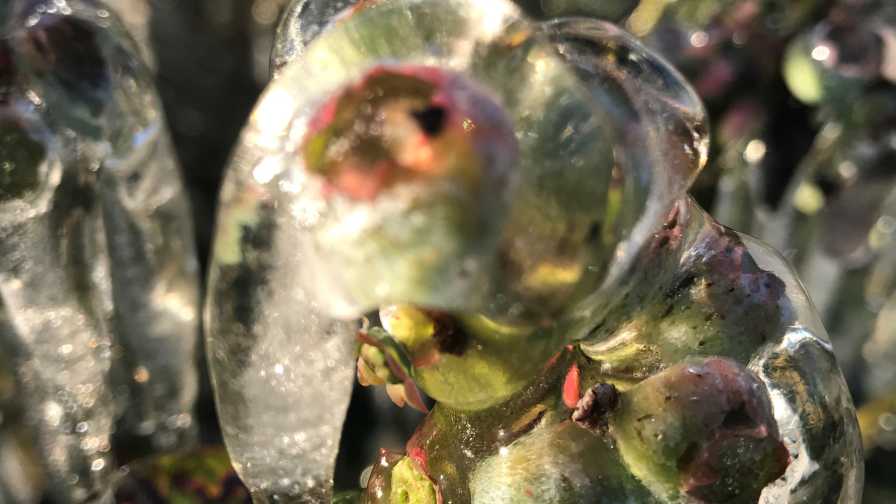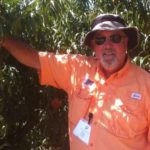Freeze Factors For Blueberries

Photo by Chuck Allison
To meet the goal of harvesting a high-quality blueberry crop in the market window of late March to early May, growers choose to plant southern highbush cultivars that bloom from late January through February. In many blueberry production regions in Florida, especially the central and northern portions of the state, sub-freezing temperatures associated with Arctic cold fronts put susceptible blueberry buds, bloom, and fruit at risk of being damaged. For this reason, most commercial blueberry producers utilize freeze protection methods to reduce potential damage.
Application of overhead irrigation water through solid set sprinkler systems in the field is commonly used by Florida blueberry growers for freeze protection. Properly applied overhead irrigation water forms a protective ice coating that keeps susceptible buds, flowers, and fruit at a temperature of approximately 32°F. Experience in Florida has shown that blueberry flowers can be damaged by temperatures in the mid- to high 20s and fruit can be affected by temperatures less than 32°F.
Growers are evaluating less water intensive alternative methods of freeze protection such as wind machines and high tunnels. Wind machines mix the warmer upper air with cooler air adjacent to the soil when temperature inversions form during freezes on calm nights. High tunnels are non-permanent structures made of metal tubing and clear plastic covering that hold warmer air inside, thus vastly reducing the amount of water needed to protect the crop. It must be noted that there is significant initial expense associated with both of these systems.
Overhead Irrigation Instruction
The irrigation system’s design should have a coefficient of uniformity of 80% or more. Many factors can affect this value and you should consult an irrigation design expert for further guidance. It is important to address any uniformity issues long before the threat of freeze is near.
In addition, monitoring of weather conditions is key. The Florida Automated Weather Network or FAWN (Fawn.ifas.ufl.edu) from UF/IFAS has a “Cold Protection Toolkit” containing numerous tools to aid in evaluation of key weather data during freeze events.
Other online resources, such as the National Weather Service (NWS, Accuweather.com), Weatherunderground.com, and others provide various services. Some UF/IFAS Extension agents have weather watch services that charge a fee for specialized forecasts generated by a retired NWS Meteorologist.
Dewpoint temperature is an indication of the moisture content of an air mass. The lower the dewpoint, the higher the potential for temperatures to drop. Wind mixes air and tends to even the temperature in a field, while calm conditions often result in a temperature inversion where lowest temperatures are adjacent to the ground. Potential for evaporative cooling, reduction in temperature associated with the evaporation of water, increases when there is significant wind and the air is very dry (low dewpoint). Wet bulb is the temperature to which a dry plant surface will drop due to evaporative cooling when moisture, such as initial irrigation water, is introduced into a field.
Cool Tool
The Wet-Bulb Based Irrigation Cutoff Temperature tool on FAWN indicates the safe temperature to turn your system off after a freeze. Monitoring the wet bulb temperature before turning the sprinklers on also is important as the temperature in the field tends to initially “crash” to the wet bulb temperature as some of the water evaporates during start up. Many growers that monitored wet bulb temperature before turning their systems on during the February 2012 freeze escaped with little damage to their developing blueberry fruit.
For more information, consult the UF/IFAS Extension publication titled “Protecting Blueberries From Freezes In Florida.”
To Serve And Protect
In addition to sprinklers, below are some other tactics that can be employed to reduce the risk from freeze.
- Site Selection: A farm designed to achieve optimum cold air drainage is less susceptible to freeze, especially during calm wind conditions.
- Cultivar Selection: Growers may be able to lower the probability of dealing with freeze events by choosing blueberry cultivars that bloom later but still produce fruit in the optimum marketing window.
- Dormancy: Practices like managing fertility and soil moisture to allow the crop to enter dormancy at the proper time in the fall can make blueberry plants less susceptible to freeze damage.
- Soil Moisture: Growers that irrigate their field the afternoon before an expected freeze event can experience 2°F to 3°F higher temperature in their field vs. a field with lower soil moisture and thus may possibly be able to reduce or even avoid running their irrigation system for freeze protection during the night.










